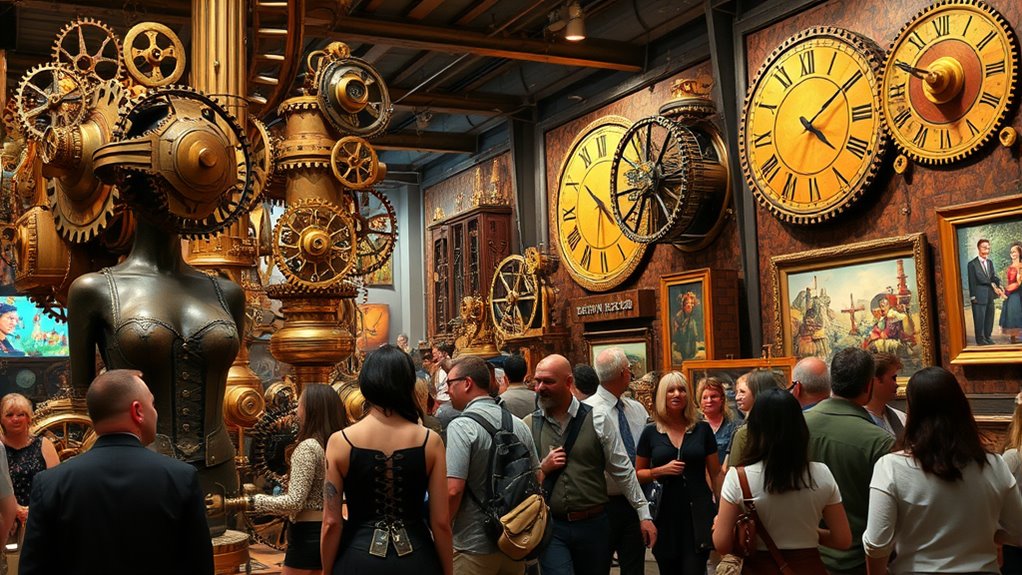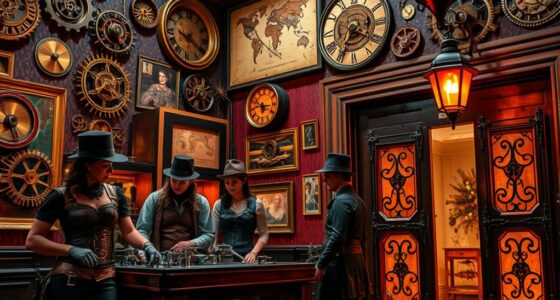The steampunk art movement blends Victorian elegance with futuristic innovation, featuring artists who craft intricate gear-filled designs and imaginative machinery inspired by 19th-century aesthetics. You’ll find jewelry with cogs, costumes with goggles, and sculptures mimicking clockwork complexity, all emphasizing craftsmanship and detailed craftsmanship. This movement celebrates a harmonious mix of past influences and future visions, creating a unique universe of exploration and discovery. To explore the key figures and signature creations shaping this genre, stay tuned.
Key Takeaways
- Steampunk art combines Victorian aesthetics with futuristic innovation, emphasizing craftsmanship, gears, and brass details.
- Key artists create jewelry, costumes, and sculptures inspired by clockwork mechanisms and Victorian motifs.
- Artistic elements blend traditional craftsmanship with sci-fi elements like airships, steam-powered devices, and glowing lights.
- Themes focus on exploration, discovery, and the harmony of past Victorian elegance with futuristic imagination.
- The movement celebrates detailed design, inventive craftsmanship, and visual storytelling that reimagines history and technology.

The Steampunk Art Movement combines Victorian-era aesthetics with futuristic imagination, creating a unique blend of old-world craftsmanship and inventive design. You’ll notice that Victorian influences are deeply woven into the movement’s visual language, showcasing intricate gears, brass fittings, lace details, and ornate embellishments that evoke the elegance and sophistication of 19th-century design. These elements serve as a nostalgic nod to a bygone era, but they’re reimagined with a modern twist, transforming traditional aesthetics into something futuristic and innovative. As you explore steampunk creations, you’ll see how artists incorporate Victorian motifs into contemporary contexts, seamlessly blending the past and future into a cohesive aesthetic.
Futuristic aesthetics play a crucial role in shaping the distinctive look of steampunk art. It’s not just about replicating Victorian styles but about imagining what the future might have looked like through the lens of that era’s technology and craftsmanship. You might encounter sleek, mechanical components paired with vintage materials, creating a visual dialogue between old and new. The movement often features airships, clockwork mechanisms, and steam-powered devices, all imagined through a lens that emphasizes innovation and adventure. These futuristic elements aren’t just decorative; they symbolize a world where Victorian ingenuity has evolved into a science-fiction landscape filled with possibilities. The combination invites you to step into a universe where past innovations inspire future technologies, often emphasizing a sense of exploration and discovery.
Futuristic elements in steampunk blend vintage craftsmanship with innovation, inspiring exploration and a science-fiction-inspired universe.
Artists within the steampunk movement are masters at balancing these influences. They draw inspiration from Victorian fashion, architecture, and industrial design, infusing their work with a sense of craftsmanship and detail that’s immediately recognizable. At the same time, they incorporate futuristic aesthetics—think of sleek metallic surfaces, glowing lights, and inventive contraptions—that challenge traditional notions of design. You might see jewelry with gears and cogs, costumes adorned with corsets and goggles, or sculptures that mimic the complexity of clockwork machinery. These creations invite you to appreciate the artistry behind combining historical influences with imaginative concepts, creating a universe that feels both nostalgic and forward-looking.
In essence, the steampunk art movement celebrates the harmony of Victorian influences and futuristic aesthetics. It’s about envisioning a world where innovation and craftsmanship go hand in hand, inspiring you to think creatively about how the past can influence the future. Whether through visual art, fashion, or design, steampunk invites you to explore a hybrid universe—one that’s rooted in history, yet bursting with possibilities for tomorrow.
Frequently Asked Questions
How Did Steampunk Art Originate Historically?
You might find that steampunk art originated during the Victorian innovation era, inspired by the Industrial Revolution’s technological advances. This movement blends historical Victorian aesthetics with futuristic imagination, reflecting a fascination with steam-powered machinery and craftsmanship. As you explore steampunk, you’ll notice how it combines these elements to create a unique, retro-futuristic style rooted in the technological optimism and craftsmanship of that transformative period.
What Materials Are Commonly Used in Steampunk Artworks?
You’re curious about what materials bring steampunk artworks to life. Expect a mix of mechanical assemblages—cogs, gears, and brass fittings—that create a sense of intricate complexity. Victorian-inspired textiles add a touch of elegance and history, blending the old with the new. These materials, carefully combined, evoke a world of adventure and innovation. As you explore, you realize every piece tells a story through its vivid, tactile details.
Who Are the Most Influential Contemporary Steampunk Artists?
You should explore contemporary steampunk artists like David Roeder and Miss Missy, who embody Victorian aesthetics and showcase visionary craftsmanship. They create intricate sculptures, jewelry, and costumes that blend vintage Victorian elements with futuristic imagination. Their work often features gears, brass, and leather, capturing the essence of steampunk’s inventive spirit. By studying their art, you’ll gain insight into how modern artists reinterpret and elevate this enthralling genre.
How Does Steampunk Art Influence Modern Pop Culture?
You see how steampunk art influences modern pop culture by blending Victorian aesthetics with technological nostalgia, creating a unique vintage-futuristic vibe. This style inspires fashion, movies, and video games, encouraging innovation while honoring history. When you encounter steampunk elements in media, it sparks imagination, connecting past and future. Its influence encourages creative storytelling and design, making it a lasting trend that shapes contemporary culture with a nostalgic yet futuristic appeal.
Are There Specific Techniques Unique to Steampunk Art?
You’ll notice that steampunk art uses unique techniques like intricate gear motifs and Victorian aesthetics to create its distinct look. These artists often combine metalwork, leather, and antique-inspired details, making their work feel like stepping into a bygone era. The craftsmanship is so meticulous it’s as if time itself bends to their will. This blend of old-world charm and mechanical innovation defines steampunk’s signature style.
Conclusion
As you delve into the steampunk art movement, imagine stepping into a world where gears turn and steam rises like a heartbeat of creativity. Just like a clockwork mechanism, each artist’s work interlocks, revealing a rich tapestry of innovation and nostalgia. When you see a handcrafted clock or a soaring airship sculpture, remember—they’re not just art, but echoes of a future imagined through the lens of the past, forever turning forward.









